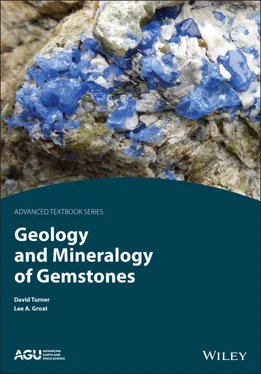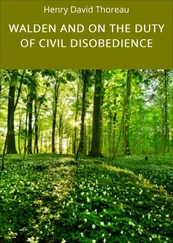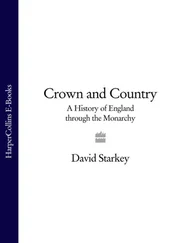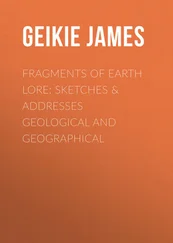1 Cover
2 Series Page
3 Title Page
4 Copyright Page
5 Preface
6 Acknowledgements
7 Part I: Developing Base Knowledge 1 Minerals and Mineralogy1.1 Minerals and Rocks 1.2 What is a Gemstone? 1.3 Atoms, Elements, and Bonding 1.4 Physical Properties of Minerals References 2 Basics of Rocks and Geology2.1 Earth System Science 2.2 The Earth’s Structure and Plate Tectonics 2.3 General Rock Types and the Rock Cycle 2.4 Metasomatism and Hydrothermal Fluids 2.5 Geological Structures 2.6 Important Rock Types for Gemstone Deposits 2.7 Weathering, Sedimentation, and Secondary Gem Deposits References 3 Intermediate Mineralogy3.1 Structure and Chemistry of Minerals 3.2 Light References 4 Concepts of Gemmology and Tools4.1 Concepts of Gemmology 4.2 Tools References
8 Part II: Gemstones and Their Origins 5 Diamond5.1 Introduction 5.2 Basic Qualities of Diamond 5.3 Common Diamond Treatments 5.4 Synthetic Diamond 5.5 Geology of Diamond and Kimberlite 5.6 Global Distribution and Production of Diamond 5.7 Diamonds from Canada 5.8 The 4 Cs 5.9 Diamond Shapes 5.10 Diamond Valuation 5.11 Kimberley Process: A 5th C? References 6 Corundum6.1 Introduction 6.2 Basic Qualities of Corundum 6.3 Faceted Gem Corundum 6.4 Corundum Valuation 6.5 Corundum Treatments, Synthetics, and Imitations 6.6 Geology of Gem Corundum: Three Main Genetic Models 6.7 Rarity of Gem Corundum 6.8 Global Distribution and Production of Corundum References 7 Beryl7.1 Introduction 7.2 Basic Qualities of Beryl 7.3 Beryl Valuation 7.4 Common Treatments, Synthetics, and Imitations 7.5 Geology of Gem Beryl: Three Main Genetic Models 7.6 Large Beryl Crystals 7.7 Global Distribution of Beryl References 8 Pegmatites8.1 Introduction 8.2 Pegmatite Mineralogy 8.3 Pegmatite Genesis 8.4 Geochemical Families of Pegmatites 8.5 Pegmatite Morphology 8.6 Corrosion 8.7 Rarity of Gem‐Bearing Pegmatites 8.8 Tourmaline 8.9 Spodumene 8.10 Topaz References 9 Chrysoberyl9.1 Introduction and Basic Qualities of Chrysoberyl 9.2 Geology of Gem Chrysoberyl References 10 Spinel10.1 Introduction and Basic Qualities of Spinel 10.2 Geology of Gem Spinel References 11 Tanzanite11.1 Introduction and Basic Qualities of Tanzanite 11.2 Geology of Tanzanite References 12 The Garnet Group12.1 Introduction and Basic Qualities of the Garnet Group 12.2 Geology of Gem Garnet References 13 Jade: Jadeite and Nephrite13.1 Introduction and Basic Qualities of Jade 13.2 Geology of Jade References 14 Quartz and Silica Gems14.1 Introduction and Basic Qualities of Quartz and Silica Gem Varieties 14.2 Quartz 14.3 Amethyst 14.4 Agate 14.5 Opal References 15 Other Gems15.1 Olivine 15.2 Turquoise 15.3 Lapis Lazuli 15.4 Zircon References 16 Organic Gems16.1 Amber 16.2 Ammolite References
9 Index
10 End User License Agreement
1 Chapter 1 Table 1.1 Atomic masses and physical properties of selected elements and the... Table 1.2 Approximate abundance of dominant elements in the Earth’s crust. D...
2 Chapter 3 Table 3.1 Parameters, symbols, and definitions for the anatomy of a wave.
3 Chapter 5Table 5.1 Common characteristics of colored diamonds from the perspective of...Table 5.2 Characteristics of colored diamonds from the perspective of type *...
4 Chapter 7Table 7.1 Gem varieties of beryl along with the dominant deviations from th...
5 Chapter 8Table 8.1 Generalized geochemistry of typical granite, common pegmatite, an...Table 8.2 Selected gemstones found in granitic pegmatites, sorted by rarity...Table 8.3 Commonly known gem varieties of tourmaline and their characterist...
6 Chapter 12Table 12.1 Compositions of the garnet mineral species in the pyralspite and...
7 Chapter 15Table 15.1 Common minerals in lapis lazuli.
8 Chapter 16Table 16.1 Relevant physical properties of amber (Data from Ross, 2010).
1 Chapter 1 Figure 1.1 An atomic model of the element helium (He), with two protons, two... Figure 1.2 An atom can lose electrons and become a cation, a positively char... Figure 1.3 Periodic table of the elements with atomic numbers and chemical a... Figure 1.4 Relative abundance of the elements in the Earth's crust as compar... Figure 1.5 This crystal of corundum shows rhombohedral parting patterns and ... Figure 1.6 This cluster of bladed kyanite crystals shows brittle tenacity an...
2 Chapter 2 Figure 2.1 The Earth System. A schematic model of the Earth as a series of i... Figure 2.2 Simplified schematic of the Earth’s principal internal geological... Figure 2.3 The major tectonic plates of the Earth, their boundaries, and rel... Figure 2.4 This cross‐section illustrates the main types of plate boundaries... Figure 2.5 Schematic diagrams of (a) continental–continental convergent plat... Figure 2.6 Map and aerial view of the San Andreas Fault that cuts across the... Figure 2.7 Thickness contour map of the of the Earth's crust, developed from... Figure 2.8 Simple and generalized classification diagram for igneous rocks, ... Figure 2.9 Simple and generalized classification diagram for sedimentary roc... Figure 2.10 Simple diagram for metamorphic rocks based on changing temperatu... Figure 2.11 Simple diagram for metamorphic rock descriptions based primarily... Figure 2.12 This schematic of the Rock Cycle illustrates some of the most co... Figure 2.13 Idealized schematics of fluid flow through the Earth’s crust wit... Figure 2.14 Schematics of three fault types: reverse, normal, and strike‐sli... Figure 2.15 Schematics of three folding patterns of layered rocks. Here, the... Figure 2.16 Faulting (red dashed line) and folding (yellow dashed line) in l... Figure 2.17 Schematic diagram of diamonds hosted in kimberlite pipes that ar...
3 Chapter 3 Figure 3.1 Shapes of different unit cells of crystal systems, as defined by ... Figure 3.2 The top row shows polyhedra from example minerals, the bottom row... Figure 3.3 Crystal structure of beryl visualized using polyhedra (top row) a... Figure 3.4 Anatomy and equation of a wave. Figure 3.5 The refraction and interaction of light between two media: air an... Figure 3.6 The refractive indices for various materials across the visible r... Figure 3.7 The visible portion of the electromagnetic spectrum with Fraunhof... Figure 3.8 Incident light can refract and reflect (red rays) if the angle of... Figure 3.9 Electromagnetic spectrum labeled with representative colors. Wiki... Figure 3.10 Examples of light reflecting off different surfaces. Image from ... Figure 3.11 Additive (left) and Subtractive (middle) Color Theory Diagrams (...Figure 3.12 Light output from three sources of electromagnetic radiation. No...Figure 3.13 Example spectra of light output from different “colored” LEDs (a...Figure 3.14 The “color change effect” exhibited by a single 17.08 carat alex...Figure 3.15 Plot showing the change of diamond’s refractive index as a funct...Figure 3.16 Schematic of a prism with light refracting after passing through...Figure 3.17 This large 898 carat faceted cerussite (PbCO 3) from Namibia, kno...Figure 3.18 Double refraction of lines drawn on paper as viewed through a si...Figure 3.19 Titanite is a rare gem mineral (but common mineral) that has a h...Figure 3.20 Peridot (left) and turquoise (right) are common idiochromatic ge...Figure 3.21 The Gachala Emerald (858 carats) from Colombia is an example of ...Figure 3.22 Very large calcite gem (1,865 carats) from St. Joe #2 Mine, Balm...Figure 3.23 Six‐rayed star in ruby (left) and chrysoberyl (right) from Sri L...Figure 3.24 Sunstone (left) showing strong iridescence from light scattered ...Figure 3.25 Pleochroism in a synthetic sapphire, as viewed with a polaroid‐p...Figure 3.26 Pleochroism in a tourmaline cut with the c‐axis parallel to the ...Figure 3.27 Transparent specimen of pink zoisite. Smithsonian National Museu...Figure 3.28 These sunstones from Oregon, USA, show varying degrees of transp...Figure 3.29 This piece of carved imperial jadeite from Burma (13.7 carats) s...Figure 3.30 Turquoise is a common semitranslucent to opaque gemstone. Specim...
Читать дальше












